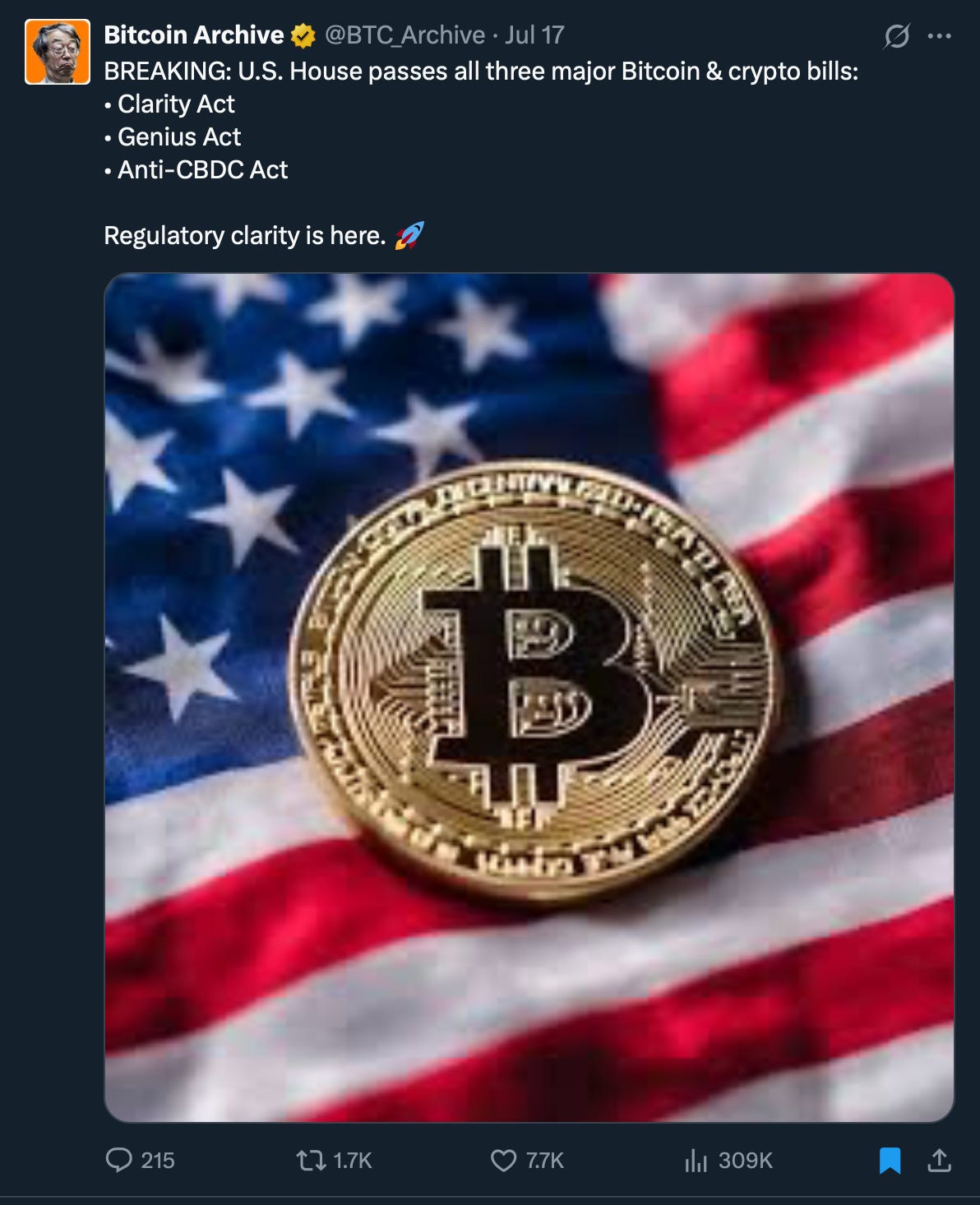💡 Are CBDCs Evil?
Issue 175
✌️ Welcome to the latest issue of The Informationist, the newsletter that makes you smarter in just a few minutes each week.
🙌 The Informationist takes one current event or complicated concept and simplifies it for you in bullet points and easy to understand text.
🫶 If this email was forwarded to you, then you have awesome friends, click below to join!
👉 And you can always check out the archives to read more of The Informationist.
Today’s Bullets:
What are CBDCs?
The Genius Act—A CBDC Backdoor?
The Anti-CBDC language
The Genius of Bitcoin
Inspirational Tweet:
Some key Bitcoin & crypto bills just passed the House and found their way to the President’s desk for signage into law this week.
But were the bills just a sneaky way to introduce total financial (and social) control? A Central Bank digital Currency (CBDC) trojan horse, so to speak?
And what’s the big deal, anyway, right? I mean a CBDC is just a digital dollar, which we arguably already have, right?
Well, not exactly.
In fact, it is much more sinister than that, which we will get into today.
But don’t worry, we will do it nice and easy, as always.
So, pour yourself a big cup of coffee and settle into your favorite chair for a venture down the CBDC alley with this Sunday’s Informationist.
🤔 What are CBDCs?
In simple terms, a Central Bank Digital Currency (CBDC) is state-sponsored digital cash.
But it’s not ‘just digital cash’.
Let me explain.
First, a CBDC is a direct liability of the central bank, not a commercial bank deposit.
And so, because it operates on infrastructure that the state (and/or its regulated intermediaries) can update or condition, it adds policy control surfaces that cash and today’s credit card / bank combinations don’t have.
If you have never heard of CBDCs or don’t yet know what makes this control so special, then you may be asking, Why does this matter?
Let’s take China as an example.
While most countries are still researching or drafting proposals, China’s digital yuan (e-CNY) is already implemented and shows how a government can manipulate programmable money in your daily life.
See, in its pilot program, trillions of yuan have already been distributed through staged city rollouts tied to transit, shopping events, public services, and government giveaways.
In a sly move, Chine didn’t try to have the e-CNY replace familiar apps; it embedded itself inside what people already use—WeChat Pay, Alipay, major bank apps, merchant QR codes.
This “attach to existing rails” strategy quietly lowered friction and accelerated usage without a strict mandate.
Then, China implemented a “managed anonymity” model which assigns wallet tiers.
Minimal ID = low limits; deeper KYC = higher balances and transaction ceilings.
And this creates a dial the authorities can turn per person or group.
On top of that, smart-contract disbursements allow for targeted vouchers and subsidies: i.e., money that appears only if you meet a condition (spend in a district, buy within a limited timeframe, invest in R&D, etc.) and can expire if you don’t use it.
Great for stimulus controls, sure—but also a template for disaster.
At some point, every retail payment will carry standardized metadata (wallet tier, merchant category, location, time), allowing for total control:
Merchant / category rules: automatic limits on fuel, gaming, or luxury spending
Time or location windows: vouchers spendable only inside a disaster zone this week, or that evaporate tonight to force quick usage
Automatic tax / fee capture: VAT, congestion pricing, small fines skimmed at the moment of payment instead of after reconciliation
Differential interest: negative or zero interest rates above a holding threshold; bonus credits for targeted demographics
Policy “green” mandates (already proposed in papers): micro-rebates for low-emission transit, higher fees after a personal carbon allowance is exceeded, or even total limits on carbon footprints
And soon, national digital IDs will link each wallet to a specific, verified identity.
Say goodbye to the sovereign individual.
The obvious issue here is that this enables granular profiling, selective throttling (slower or denied payments for flagged individuals), or conditional access tied to social or political compliance. 😱
To give you an idea of the horror this proposes, consider a day in the life of a CBDC society.
Morning: your transit subsidy auto-loads but only if you log into public transport by 9am
Lunch: a targeted dining voucher works only inside your 3 mile-radius work district and expires at 3pm
Afternoon: a second fuel purchase is partially denied because you hit a weekly carbon or fuel category cap
Evening: an online item purchase is blocked because your ID level was downgraded due to a social media post that was deemed ‘critical of the government’
Month-end: the balance above your allowed savings threshold is penalized with a negative interest rate or auto-swept into a “stimulus” spend bucket, where your savings are seized and redistributed to others.
Every step uses programmable rules tied to identity for a seamless and cynical experience.
Ah, you say, but we aren’t China. We aren’t communist here in the US or the West.
Make no mistake. This Chinese pilot is being used as an example in Congressional debates.
The Good News:
The current US path—federally regulated private stablecoins (GENIUS Act) plus advancing Anti-CBDC language that would bar a Federal Reserve retail token—aims to avoid constructing any centralized control provision in the first place.
The Bad:
We aren’t quite there yet.
🏛️ The Genius Act—A CBDC Backdoor?
While most headlines focused on political theater this past week, something far more foundational quietly became law: the GENIUS Act.
I wrote all about the GENIUS Act recently, and if you have not read that or want a refresher, you can find it right here:
For the TL;DR: crowd, here’s an updated summary.
After a decisive 308–122 vote in the House, and earlier bipartisan support in the Senate (68–30), the Guiding and Establishing National Innovation for U.S. Stablecoins, or GENIUS Act, was signed into law by President Trump this week. With that signature, the US regulated private stablecoins.
So what does the law actually do?
GENIUS creates a clear, legal definition for “payment stablecoins.”
These are digital tokens tied 1:1 to the US dollar and backed by reserves—think cash, short-term Treasuries, or overnight repo. Under this new law, only approved issuers—US banks, credit unions, or qualified non-bank financial firms—can legally offer these tokens to the public.
Of course, it’s not just about who can issue, but how. To qualify, stablecoin issuers must:
Hold 100% high-quality liquid assets (no leverage or lending)
Offer par-value redemption (your $1 token gets you $1 back—always)
Publish monthly attestations of their reserves
Stay compliant with AML, KYC, and OFAC rules
Submit to federal oversight, primarily by the OCC
Perhaps just as important is what the GENIUS Act doesn’t do.
It does not authorize the Federal Reserve to issue a CBDC, nor does it create any kind of government-run retail wallet.
The Fed is supposed to stay in the background, you know, conducting (read: manipulating) monetary policy and banking—not issuing state-sponsored digital dollars directly to you.
But the reality is that stablecoins are big—and only getting bigger.
There’s over $260 billion worth of them globally, the vast majority of which are US dollar-pegged.
And until now, their regulatory status was murky at best. Are they securities? Commodities? Bank liabilities?
The GENIUS Act finally settles this in the US, giving institutional players the confidence they need to build on top of these tokens—payments, settlements, remittances, even collateral.
GENIUS cements regulated stablecoins as an outlet for the US Treasury to continue to operate in deficit and issue more and more…
and more…
and more…
US Treasuries.
Great news for the hopeless leaders in DC, no spending curb on them!
That said…
Some people say GENIUS opens the door to a multi-trillion-dollar ecosystem of tokenized “narrow money”—fully backed, non-lending digital cash. Think money market funds in your wallet, but programmable.
And this could enable large tech and payment companies to expand the government’s direct surveillance reach.
But the GENIUS Act bill coincides with a separate bill in Congress, called the Anti-CBDC Surveillance State Act, which would ban the Federal Reserve from creating or distributing a CBDC to individuals.
In other words:
GENIUS legalizes private tokenized dollars under federal guardrails.
Anti-CBDC legislation seeks to permanently close the door to a programmable, government-issued retail dollar.
Let’s see how, shall we?
Keep reading with a 7-day free trial
Subscribe to The Informationist to keep reading this post and get 7 days of free access to the full post archives.


